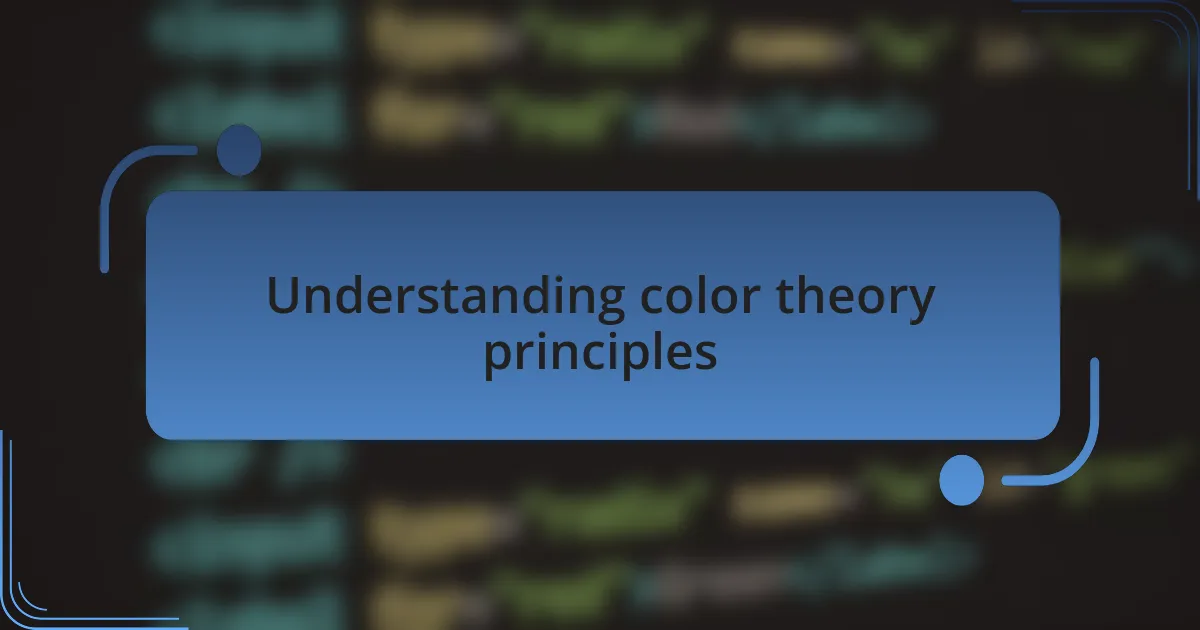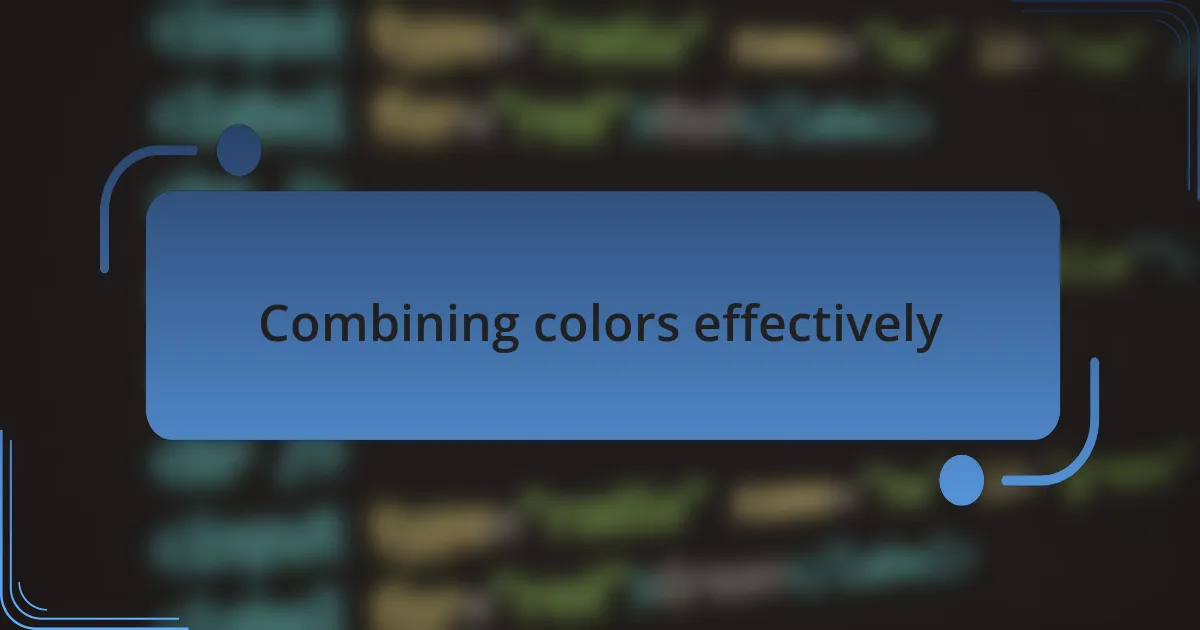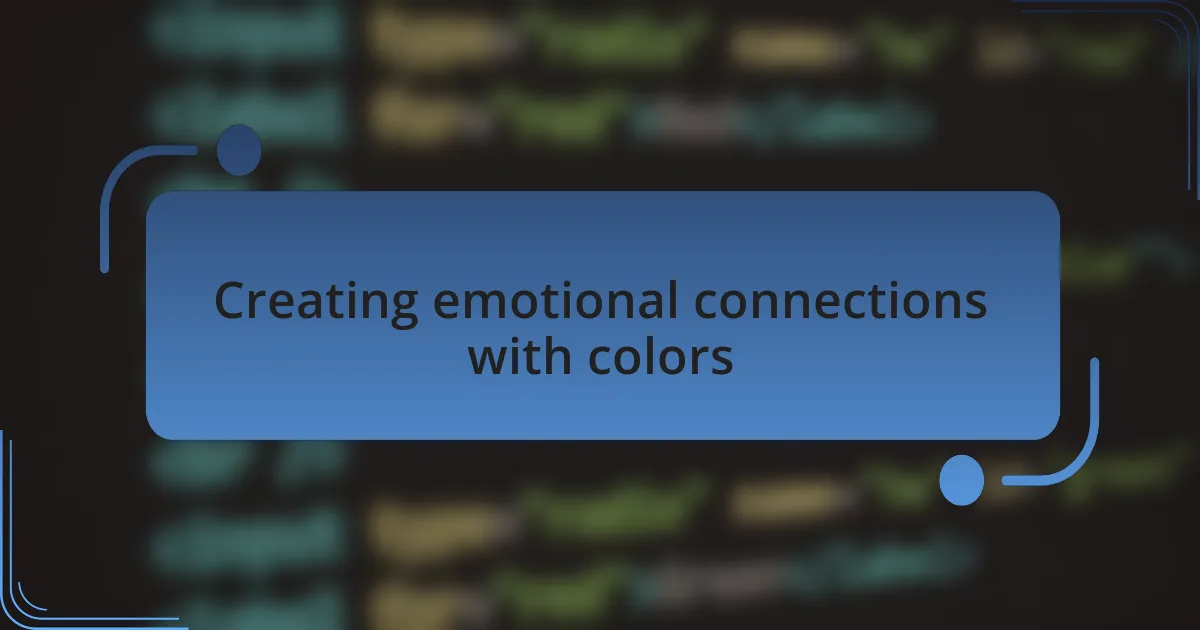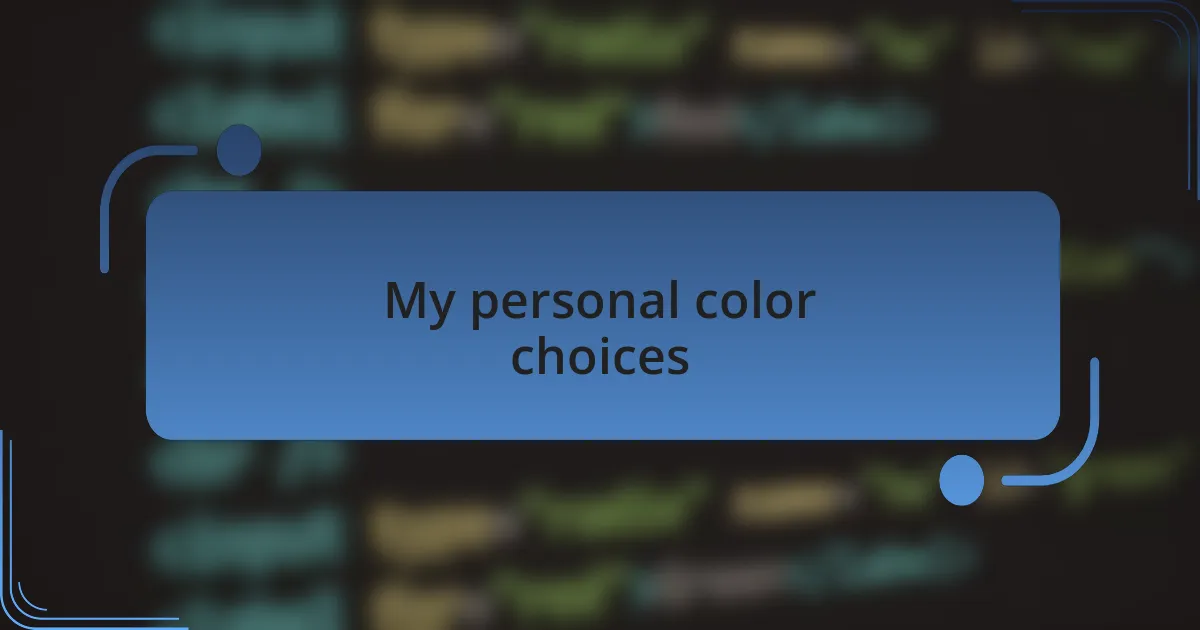Key takeaways:
- Understanding color theory enhances web design by impacting both aesthetics and user emotions.
- Choosing a color palette involves context; colors can reflect brand identity and set mood effectively.
- Effective color combinations utilize contrast and simplicity to guide user focus and enhance readability.
- Colors have emotional resonance, and thoughtful selections can create connections and narratives that engage users.

Understanding color theory principles
Color theory principles are the backbone of effective web design, shaping not just the aesthetics but also the emotional impact of a site. I remember my first experience choosing a color palette for a client’s website; I was so focused on looking ‘trendy’ that I overlooked the psychology behind each shade. A deep blue often conveys trust, while a vibrant red can evoke excitement – understanding these nuances transforms mere design into a powerful communication tool.
One principle that always strikes a chord with me is the concept of complementary colors. When I paired a soft yellow with a rich purple in a recent project, it was as if the colors danced together, creating a vibrant visual harmony. Have you ever noticed how certain color combinations can instantly uplift your mood? That’s the magic of understanding how colors interact – it’s the difference between an inviting website and one that feels disjointed.
The use of color harmony can be a game-changer in web design. I once experimented with analogous colors, choosing shades that sit next to each other on the color wheel for a startup site, and the result was a soothing and cohesive look. This experience taught me how essential it is to consider not just individual colors but the overall palette’s flow; it’s about more than aesthetics—it’s about creating an experience that resonates with users on an emotional level.

Choosing a color palette
Choosing a color palette is an exhilarating yet challenging process. I’ll never forget the time I helped a local bakery revamp their website. We decided on pastel hues, which not only reflected the sweetness of their offerings but also created an inviting, warm atmosphere. Have you ever walked into a shop and felt instantly welcomed? That’s the power of color; it can set the mood even before someone reads a single word.
I really emphasize the importance of context when selecting colors. For instance, I once worked on an e-commerce site for eco-friendly products where earthy tones like greens and browns made sense. It felt as if we were inviting visitors into a natural space, reinforcing their commitment to sustainability. Isn’t it interesting how colors can underscore your brand’s message and values?
One insight I’ve gleaned over the years is to avoid overwhelming the viewer with too many bold shades. I remember a project where I naively tried to incorporate an array of bright colors, thinking it would attract attention. Instead, it created visual chaos that detracted from the content. Sometimes, a limited palette with a few striking accent colors can be far more effective in guiding the user’s focus and enhancing their overall experience. Have you ever found yourself distracted by too much variety? Simplicity often wins in the world of web design.

Combining colors effectively
When it comes to combining colors effectively, contrast plays a pivotal role. I remember a project where we paired a deep navy blue with striking yellow accents. The contrast not only drew the eye to important buttons but also created a visual hierarchy that guided users effortlessly through the site. Have you ever noticed how certain color combinations can make information pop? It’s about making sure that what matters most stands out.
Another technique I’ve found helpful is using analogous colors—those that sit next to each other on the color wheel. I had a client looking to create a calming atmosphere for a wellness blog. By combining soft blues and greens, we achieved a smooth and harmonious look that made visitors feel relaxed. Doesn’t it feel nice when your environment promotes tranquility? Just remember, while these shades blend beautifully, adding a splash of a complementary color can add that necessary visual interest.
I’ve also learned that sometimes less is more, especially when combining colors. There was a website redesign I undertook where the initial draft was a riot of colors. I decided to simplify to two primary colors, with one or two accent shades for details. The transformation was astounding; it not only looked cleaner but also felt more professional. Isn’t it fascinating how clarity can often replace complexity in design? Embracing a minimalist approach can transform your color combinations from chaos to elegance.

Creating emotional connections with colors
Colors evoke emotions and can create profound connections with users on a web page. I still recall a branding project where my team used warm tones like soft reds and oranges for a food delivery service. The colors made the website feel inviting and energetic, almost as if it was whispering, “Come indulge your cravings!” Have you felt that warmth from a color palette? It’s remarkable how the right choices can pull at your heartstrings and influence your mood.
I’ve found that each color has its own unique emotional weight. For instance, when designing an ecommerce site for a luxury skincare line, I opted for muted pastels combined with gold accents. This choice didn’t just represent luxury; it narrated a story of soothing rituals and pampered experiences. Don’t you think colors can tell tales of their own? A good design doesn’t merely present a product; it invites users into an emotional journey.
Using color to create emotional resonance is not just about aesthetics—it’s about crafting experiences that linger in the minds of users. I remember a project for a non-profit focused on mental health awareness, where we chose serene blues and soft greens. Many users shared that visiting the site brought them a sense of calm and hope. Isn’t it magical how a carefully selected palette can transform a digital space into a comforting refuge? Each color can act as a silent partner in a powerful narrative, guiding users through the emotional landscape of your brand.

My personal color choices
Colors are deeply personal to me, and my choices often reflect my own experiences and emotions. For a recent project centered on wellness, I gravitated towards earthy greens and soft browns, reminiscent of my time hiking in the mountains. Every time I see those colors, I’m transported back to the tranquility of nature, and I hope to evoke that same sense of peace in visitors to the site.
One of my favorite color combinations is a vibrant teal paired with warm coral. I remember using this palette for an artisan markets website, which aimed to capture the spirit of the local community. It almost felt like an invitation to stroll through a lively market, with the colors bursting with energy and creativity. Have you ever picked a color that just felt like home? When colors resonate on a personal level, the visual experience becomes richer and more inviting.
For me, color selection goes beyond design—it’s about crafting a narrative that connects with others. When I worked on a campaign for a children’s charity, I chose playful yellows and cheerful pinks to evoke joy and optimism. The feedback was overwhelming; parents told me that those colors filled them with hope and happiness. Isn’t it fascinating how fleeting glimpses of color can create lasting impressions? Each selection isn’t just about looking good; it’s about leaving a mark on the hearts of those who encounter it.